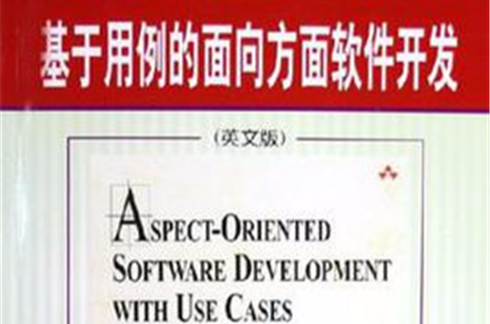《基於用例的面向方面軟體開發》是2006年機械工業出版社出版的圖書,作者是雅各布森。
基本介紹
- 書名:基於用例的面向方面軟體開發
- 作者:(美)雅各布森
- ISBN:7111177711
- 頁數:418頁
- 出版社:機械工業出版社
- 出版時間:2006年1月1日
- 裝幀:平裝
- 開本:16
- 叢書名:經典原版書庫
作者簡介,內容簡介,目錄,
作者簡介
lvar Jacobson博士,是許多技術“之父”,這包括組件及基於組件的軟體架構,用例,現代業務工程,以及Ratlonal統一過程。他還是統一建模語言(UML)的三位創始人之一。同時他也是關於這些方法和技術的五本暢銷書籍的作者,以及兩本關於UML的引領性書籍的合著者。lvar 博士是JaczoneAB公司的創始人,在該公司他與其女兒、合作者Agneta Jacobson共同開發一套開創性的新產品,它將包括支持軟體開發的智慧型代理。同時他還是lvar Jacobson Consulting公司 (IJC)的創始人,其目標是向全世界的開發團隊推廣優秀的軟體開發實踐。
Pan-Wei Ng博士,在lvar Jacobson Consulting公司(1JC)扮演了多個角色。Pan-Wel博士負責針對軟體架構、用例、疊代開發、方面技術等相關技術的最佳實踐定義、開發相關素材。這些工作通常需要基於實踐進行,才能夠確保歸納的最佳實踐切實、實用。Pan-Wel博士還積極地和客戶一起工作,以確保這些公司和項目團隊能夠,快速、安全地採用這些最佳實踐。
內容簡介
Aspect-oriented programming (AOP) is a revolutionary new way to think about software engineering. AOP was introduced to address crosscutting concerns such as security, logging, persistence, debugging, tracing, distribution, performance monitoring, and exception handling in a more effective mariner. Unlike conventional development techniques, which scatter the implementation of each concern into multiple classes, aspect-oriented programming localizes them.
Aspect-oriented software development (AOSD) uses this approach to create a better modularity for functional and nonfunctional requirements, platform specifics, and more, allowing you to build more understandable systems that are easier to configure and extend to meet the evolving needs of stakeholders.
In this highly anticipated new book, Ivar Jacobson and Pan-Wei Ng demonstrate how to apply use cases--a mature and systematic approach to focusing on stakeholder concerns--and aspect-orientation in building robust and extensible systems. Throughout the book, the authors employ a single, real-world example of a hotel management information system to make the described theories and practices concrete and understandable.
The authors show how to identify, design, implement, test, and refactor use-case modules, as well as extend them. They also demonstrate how to design use-case modules with the Unified Modeling Language (UML)-- emphasizing enhancements made in UML 2.0--and how to achieve use-case modularity using aspect technologies, notably AspectJ. Key topics include
·Making the case for use cases and aspects
· Capturing and modeling concerns with use cases
· Keeping concerns separate with use-case modules
· Modeling use-cases stices and aspects using the newest extensions to the UML notation
· Applying use cases and aspects in projects
目錄
Preface
Acknowledgments
PART I The Case for Use Cases and Aspects
Chapter 1 Problem to Attack
1.1 The Use of Components Today
1.1.1 Building a System with Components
1.1.2 Benefits of Components
1.2 Limitation of Components
1.2.1 Inability to Keep Peers Separate
1.2.2 Inability to Keep Extensions Separate
1.3 Approaching a Solution
1.3.1 Early Support for Extensions
1.3.2 Support for Extensions in UML
1.4 Keeping Concerns Separate
Chapter 2 Attacking the Problem with Aspects
2. l Approaching a Solution with Aspects
2.2 Keeping Peers Separate with Aspects
2.3 Keeping Extensions Separate with Aspects
2.4 Need for Methodological Guidance
Chapter 3 Today with Use Cases
3.1 Use Cases in Brief
3.2 USe-Case-Driven Development
3.3 Roles and Benefits of Use Cases
3.4 Gaps in the Use-Case Technique
3.5 Bridging the Gaps with Aspects
Chapter 4 Tomorrow with Use-Case Modules
4.1 Building Systems in Overlays with Use-Case Slices
4.2 Keeping Peer Use Cases Separate
4.3 Keeping Extension Use Cases Separate
4.4 Developing with Use-Case Modules
PART II Modeling and Capturing Concerns with Use Cases
Chapter 5 Modeling Concerns with Use Cases
5.1 Use-Case Modeling
5.2 Use-Case Instances and Flows of Events
5.3 Describing Use Cases
5.4 Visualizing Use-Case Flows
5.5 Summary and Highlights
Chapter 6 Structuring Use Cases
6.1 Use-Case Relationships
6.2 Use-Case Extend Relationship
6.3 Use-Case Include Relationship
6,4 Use-Case Generalization
6.5 Utility Use Cases
6.6 Summary and Highlights
Chapter 7 Capturing Concerns with Use Cases
7. l Understanding Stakeholder Concerns
7.1.1 Understanding the Problem Domain
……

